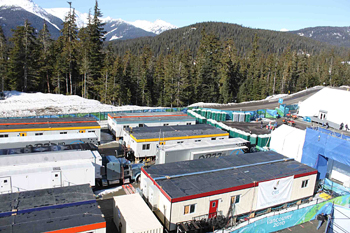Slo-Mos and XMOs in Vancouver
EVS Delivers in VancouverServers Maximize Vancouver Games Broadcast
Slo-Mos and XMOs in Vancouver
File Transfers Key in ONC Workflow
NBC: Servers for Broadcast and New Media Production
ARD, ZDF Tackle Tapeless, HD in Vancouver
NAB Workshops on Vancouver Games, FIFA World Cup
EVS established its reputation as a company that made servers optimised for slo-motion capture and replay, and grew into a full ingest, production, and playout server company. In Beijing, and now in Vancouver, EVS servers supported the latest generation of hi-speed playback, the XMO.
The XMO cameras captured some amazing pictures at the Winter Games in Vancouver. Perhaps the most memorable were up-close shots of short-track speed skaters’ blades, cutting the ice and throwing off shaved ice.
XMO is a nice three letter acronym that stands for extra motion, said Sotiris Salamouris, head of engineering for host broadcaster OBS. “We tried to call them something more official sounding like ‘super high speed cameras,’ but everybody ended up just calling them XMOs.”
Current generation broadcast cameras used in traditional slo-mo can record only up to 3× faster than standard, which translates back to 3× slower in slo-mo playback.
XMO cameras can record at frame rates quite a bit faster than this, beginning at 5 to 6× normal speed. One of the two XMO cameras deployed in Vancouver — the Super Loop from DVS — can record up to 1000 fps or more.
The other variety of XMO camera was a joint project of NEC of Japan and Panasonic, with operational support provided by Arri.
“They are different products with different capabilities and we believe we have spread them across our venues in a way to use their best qualities,” said Salamouris.
The main advantage of traditional slo-mo cameras is that they can also provide a live feed — they are used as a normal camera always providing a signal, and a director can always go back and provide the slo-mo replay. This means the camera position functions as a normal camera.

The home of many slo-mo servers — a truck compound XMOs, however, cannot function as a normal camera — they can only record clips that an operator has already decided to play back. They can only be used as replay.
An Enhanced Experience
Salamouris said that slo-mo capture and now XMO is another way broadcasters can provide the home viewer an experience impossible to be seen otherwise, even at the stadium or venue.
“In the early days of sports on television it was like an enhancement of a viewers typical experience in a stadium,” he said. “ It was like providing the viewer with nice, and fast binoculars.”
Now, broadcasting has become a true enhancement of the sports coverage because viewers can really see the effort of the athlete, the detail of their moves. “For example, in the aerials, you can see how each is landing in the snow and why one is doing better than another or why one figure skater deserves a better score,” said Salamouris.
The professional video industry's #1 source for news, trends and product and tech information. Sign up below.
